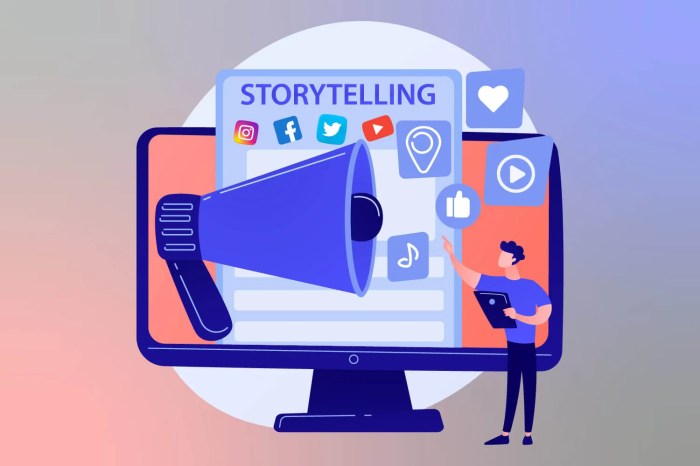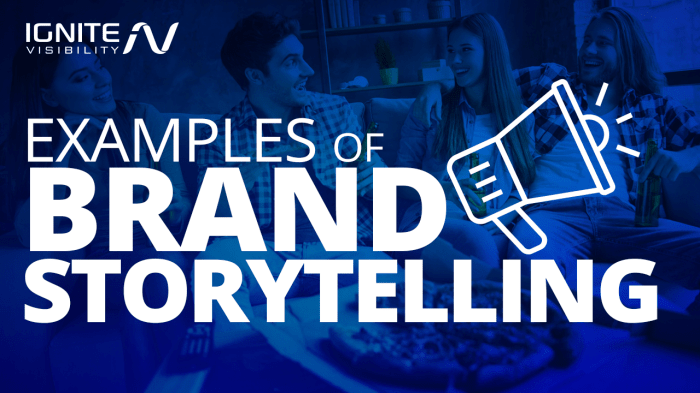Using Storytelling in Social Media Ads sets the stage for creating ads that captivate audiences through engaging narratives, showcasing brands in a unique light that resonates with viewers.
Get ready to explore the power of storytelling in social media advertising and how it can drive emotional connections and brand loyalty.
Importance of Storytelling in Social Media Ads
Storytelling plays a crucial role in social media ads as it helps brands connect with their audience on a deeper level. By weaving a narrative into their ads, companies can evoke emotions, build trust, and ultimately drive engagement and conversions.
Examples of Successful Brands Using Storytelling
- Apple: The tech giant is known for its emotionally compelling ads that focus on human experiences rather than product features. Their “Shot on iPhone” campaign, for example, showcases stunning images captured by everyday users, highlighting the power of creativity and innovation.
- Dove: Dove’s “Real Beauty” campaign challenges beauty standards and empowers women to embrace their natural beauty. By sharing real stories and experiences, Dove has successfully created a positive and inclusive brand image.
- Nike: Nike’s ads often feature powerful storytelling that inspires and motivates viewers. Their “Just Do It” campaign, for instance, is centered around stories of perseverance, determination, and overcoming obstacles.
Creating Emotional Connections with the Audience
Storytelling has the unique ability to create emotional connections with the audience by tapping into their feelings, values, and aspirations. When brands share authentic and relatable stories, they can resonate with consumers on a personal level, leading to increased brand loyalty and advocacy. By evoking emotions such as joy, empathy, or nostalgia, storytelling can leave a lasting impact on viewers and drive them to take action.
Elements of Effective Storytelling in Social Media Ads
Effective storytelling in social media ads involves incorporating key elements that captivate the audience and drive engagement. Let’s delve into the essential components that make a storytelling ad successful.
Role of Characters, Plot, and Conflict, Using Storytelling in Social Media Ads
Characters play a crucial role in storytelling ads as they help create a connection with the audience. By developing relatable characters, the audience can empathize with their journey and be more invested in the narrative. The plot serves as the backbone of the ad, guiding the storyline and keeping viewers engaged. Conflict adds depth to the story by introducing challenges that the characters must overcome, creating tension and suspense that captivates the audience.
Visuals and Sound Enhancement
Visuals and sound are powerful tools that can enhance the storytelling experience in ads. Compelling visuals, such as striking images or videos, can help set the mood, convey emotions, and immerse the audience in the story. Incorporating sound elements like music or sound effects can further enhance the emotional impact of the ad, evoking specific feelings and resonating with viewers on a deeper level.
Tailoring Stories for Different Social Media Platforms

To effectively engage audiences on various social media platforms like Facebook, Instagram, and TikTok, it is essential to tailor your storytelling approach to fit the unique characteristics and preferences of each platform.
When it comes to Facebook, longer-form storytelling tends to perform well. Users on Facebook are more likely to engage with content that provides in-depth information, such as behind-the-scenes stories, customer testimonials, and educational content. Incorporating interactive elements like polls or quizzes can also enhance engagement.
Instagram is a visually-driven platform where storytelling often revolves around captivating images and short videos. Utilize features like Instagram Stories, IGTV, and carousel posts to create visually appealing narratives that resonate with your audience. Influencer collaborations and user-generated content can also add authenticity to your stories on Instagram.
TikTok
TikTok thrives on short, snappy storytelling that captures attention quickly. Leveraging trends, challenges, and music to create relatable and entertaining content is key on this platform. Utilize TikTok’s editing tools and effects to enhance storytelling and engage with the platform’s active user base.Adapting your stories to fit the audience demographics, content formats, and engagement styles of each social media platform is crucial for maximizing the impact of your storytelling efforts.
By understanding the unique storytelling formats that work best on Facebook, Instagram, and TikTok, you can create compelling narratives that resonate with your target audience and drive meaningful interactions.
Measuring the Impact of Storytelling in Social Media Ads: Using Storytelling In Social Media Ads

Storytelling in social media ads can have a powerful impact on audience engagement and brand perception. However, it’s essential to measure the effectiveness of these storytelling efforts to ensure they are generating the desired results. Here are some methods for tracking the success of storytelling ads on social media:
Tracking Methods
- Engagement Metrics: Monitor likes, comments, shares, and clicks to gauge audience interaction with your storytelling content.
- Conversion Rates: Track the number of conversions or sales generated by your storytelling ads to measure their impact on driving actions.
- Brand Sentiment Analysis: Use tools to analyze audience sentiment towards your brand after viewing storytelling ads to assess overall perception.
Key Metrics for Evaluation
- Reach: Measure how many people were exposed to your storytelling ads to understand the potential impact on a wider audience.
- Retention: Analyze how long viewers engage with your storytelling content to determine its effectiveness in capturing attention.
- ROI: Calculate the return on investment from storytelling ads by comparing the cost of running the campaign to the generated revenue.
Optimizing with A/B Testing
A/B testing involves creating variations of your storytelling ads to test different elements and determine which performs better. By experimenting with storytelling formats, visuals, or calls-to-action, you can optimize your ads for maximum impact based on real audience responses.
